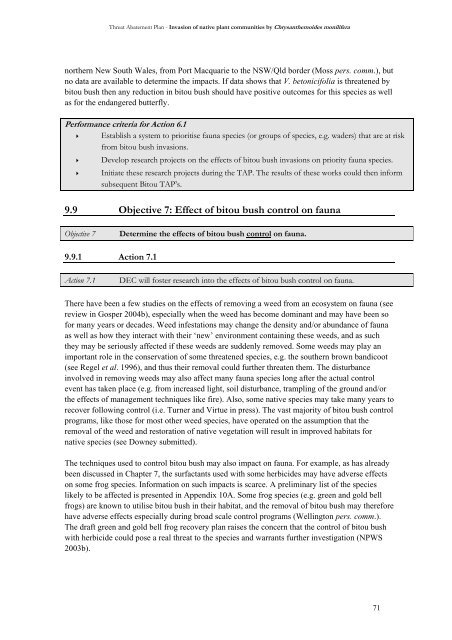NSW Bitou Bush Threat Abatement Plan - Department of ...
NSW Bitou Bush Threat Abatement Plan - Department of ...
NSW Bitou Bush Threat Abatement Plan - Department of ...
You also want an ePaper? Increase the reach of your titles
YUMPU automatically turns print PDFs into web optimized ePapers that Google loves.
<strong>Threat</strong> <strong>Abatement</strong> <strong>Plan</strong> - Invasion <strong>of</strong> native plant communities by Chrysanthemoides monilifera<br />
northern New South Wales, from Port Macquarie to the <strong>NSW</strong>/Qld border (Moss pers. comm.), but<br />
no data are available to determine the impacts. If data shows that V. betonicifolia is threatened by<br />
bitou bush then any reduction in bitou bush should have positive outcomes for this species as well<br />
as for the endangered butterfly.<br />
Performance criteria for Action 6.1<br />
< Establish a system to prioritise fauna species (or groups <strong>of</strong> species, e.g. waders) that are at risk<br />
from bitou bush invasions.<br />
< Develop research projects on the effects <strong>of</strong> bitou bush invasions on priority fauna species.<br />
< Initiate these research projects during the TAP. The results <strong>of</strong> these works could then inform<br />
subsequent <strong>Bitou</strong> TAP’s.<br />
9.9 Objective 7: Effect <strong>of</strong> bitou bush control on fauna<br />
Objective 7 Determine the effects <strong>of</strong> bitou bush control on fauna.<br />
9.9.1 Action 7.1<br />
Action 7.1 DEC will foster research into the effects <strong>of</strong> bitou bush control on fauna.<br />
There have been a few studies on the effects <strong>of</strong> removing a weed from an ecosystem on fauna (see<br />
review in Gosper 2004b), especially when the weed has become dominant and may have been so<br />
for many years or decades. Weed infestations may change the density and/or abundance <strong>of</strong> fauna<br />
as well as how they interact with their ‘new’ environment containing these weeds, and as such<br />
they may be seriously affected if these weeds are suddenly removed. Some weeds may play an<br />
important role in the conservation <strong>of</strong> some threatened species, e.g. the southern brown bandicoot<br />
(see Regel et al. 1996), and thus their removal could further threaten them. The disturbance<br />
involved in removing weeds may also affect many fauna species long after the actual control<br />
event has taken place (e.g. from increased light, soil disturbance, trampling <strong>of</strong> the ground and/or<br />
the effects <strong>of</strong> management techniques like fire). Also, some native species may take many years to<br />
recover following control (i.e. Turner and Virtue in press). The vast majority <strong>of</strong> bitou bush control<br />
programs, like those for most other weed species, have operated on the assumption that the<br />
removal <strong>of</strong> the weed and restoration <strong>of</strong> native vegetation will result in improved habitats for<br />
native species (see Downey submitted).<br />
The techniques used to control bitou bush may also impact on fauna. For example, as has already<br />
been discussed in Chapter 7, the surfactants used with some herbicides may have adverse effects<br />
on some frog species. Information on such impacts is scarce. A preliminary list <strong>of</strong> the species<br />
likely to be affected is presented in Appendix 10A. Some frog species (e.g. green and gold bell<br />
frogs) are known to utilise bitou bush in their habitat, and the removal <strong>of</strong> bitou bush may therefore<br />
have adverse effects especially during broad scale control programs (Wellington pers. comm.).<br />
The draft green and gold bell frog recovery plan raises the concern that the control <strong>of</strong> bitou bush<br />
with herbicide could pose a real threat to the species and warrants further investigation (NPWS<br />
2003b).<br />
71
















